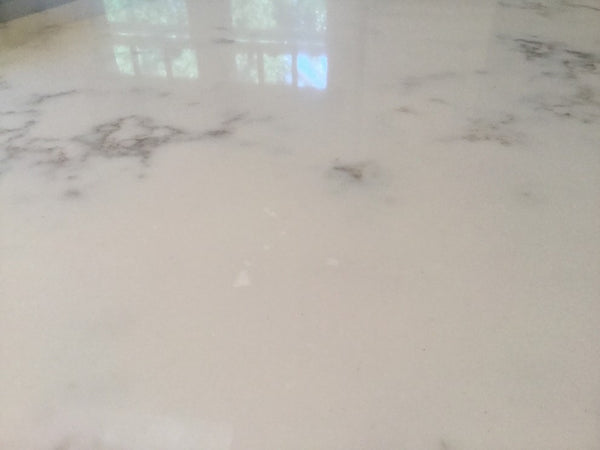Predictions point toward quartz continuing to grow in popularity over the next several years. The increase in demand is likely to lead to more imported materials. While countertops may look similar on the surface, there are problems which can be commonly found with Chinese quartz countertops, a concern for dealers and for homeowners.
According to surveys taken by the National Kitchen & Bath Association (NKBA), quartz countertops have surpassed granite as the most popular countertop material. Predictions also point toward quartz continuing to grow in popularity over the next several years.
This is good news for homeowners who want a low maintenance and consistent countertop material. Unfortunately, it also means that as demand begins to outpace supply, more dealers may feel compelled to consider importing their countertops from China, where lower cost products have emerged.
While the countertops may look similar on the surface, there can be many problems with Chinese quartz countertops, concerning for both dealers and homeowners.
Resin Pooling

Quartz countertops by name might imply that they’re made of 100% natural stone, but the beauty in this product actually lies in the fact that it’s an engineered stone. Quartz countertops are actually made up of about 93% quartz, mixed together with resin and dyes. This renders the countertop non-porous, durable, and consistent in color in a way that natural stone cannot be.
One problem that has been emerging from overseas quartz countertops – and Chinese quartz countertops in particular – is resin pooling. This is an inconsistency in the countertop that leads to large pools of colored resin marring the surface of the counter.
Inconsistent Material Quantities
While every quartz manufacturer in the North America follows strict ratios for the amount of quartz and resin they use, many Chinese products are less consistent. Some may use higher percentages of resin with less quartz stone.
This can contribute to resin pooling, and it can also make a more flexible countertop that can bend during transport. The ratio inconsistencies mean that the quality of the countertop is inconsistent, as well. You won’t know the quality of the material you’re buying as you may not be able to detect the problem visually.
Dye Lot Inconsistency
One of the reasons that homeowners like quartz is the consistency it offers in color and pattern. While natural stones like granite can vary tremendously from slab to slab, quartz is usually much more reliable.
There is always some degree of dye lot variation to be expected in any man-made product. However, this variation is controllable to some degree, and while one slab may vary slightly from another, you won’t find a lot of color changes within one slab.
Chinese quartz countertops are more likely to have dye lot variation, because the amount of resin - and therefore the amount of pigment - can vary. In investigations conducted by the US Government as to whether Chinese quartz was harming the domestic market, some slabs were found to have some inconsistencies in the product.
Combined with resin pooling, meaning a countertop can suddenly change color and pattern in some areas, this offers less confidence for homeowners.
Potential VOCs
Volatile organic compounds (VOCs) are a problem with many manufactured products. Some chemicals used in the formulation may give off gas over the first five years of the product's lifespan.
Therefore, many US states have laws that regulate what chemicals can be used in products that will be used in kitchens and near food. For example, formaldehyde is currently being phased out of cabinetry.
The way that the US defines VOCs and the way that China defines them are two vastly different things. While the US specifies the use of certain chemicals for indoor and outdoor use, China does not. This means that it may be possible that the countertops you receive from China could give off VOCs that would not be present in those made in the US.
Inconsistent Thickness
An additional problem that some dealers are experiencing in Chinese quartz countertops is an inconsistency in thickness. While a slab may be sold as 3cm, it may be slightly thicker or thinner, beyong a reasonable few millimeters tolerance.
In addition, there can be dramatic price inconsistencies between thicknesses, which can mean shortages in some thicknesses of specific colors. For a homeowner that wants one color in two thicknesses in a kitchen, this can be problematic.
Tariffs
As Chinese quartz continues to take up a larger share of the quartz market in the US, tariffs are being considered on their import. Both the Department of Commerce and the International Trade Commission are looking into duties on future imports of Chinese quartz countertops and are likely to announce duty amounts in September 2018.
This could cause a significant spike in prices, resulting in a drop in Chinese quartz supply. This sudden drop in the market could cause a temporary shortage of product, which means that any dealers and prospective buyers will need to watch the market closely and ensure that they have a consistent supply to meet their customer's demand.
Chinese Quartz vs North American Quartz Countertops
North American quartz countertops are durable, consistent, and reliable. Unlike Chinese materials, you can trust the quality, color, and material you purchase when you source North American made quartz.
While some Chinese quartz products have seemingly lower prices, this is offset by the lower quality of the product; the countertop may not last as long, perform as well, or give you the desired results. Purchase North American made quartz countertops over Chinese and avoid these issues in the future.

